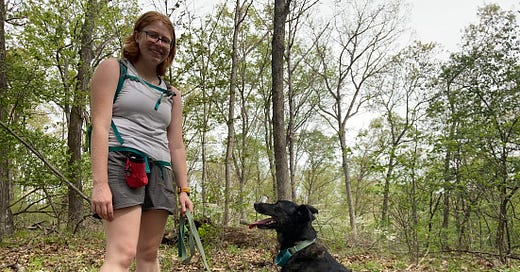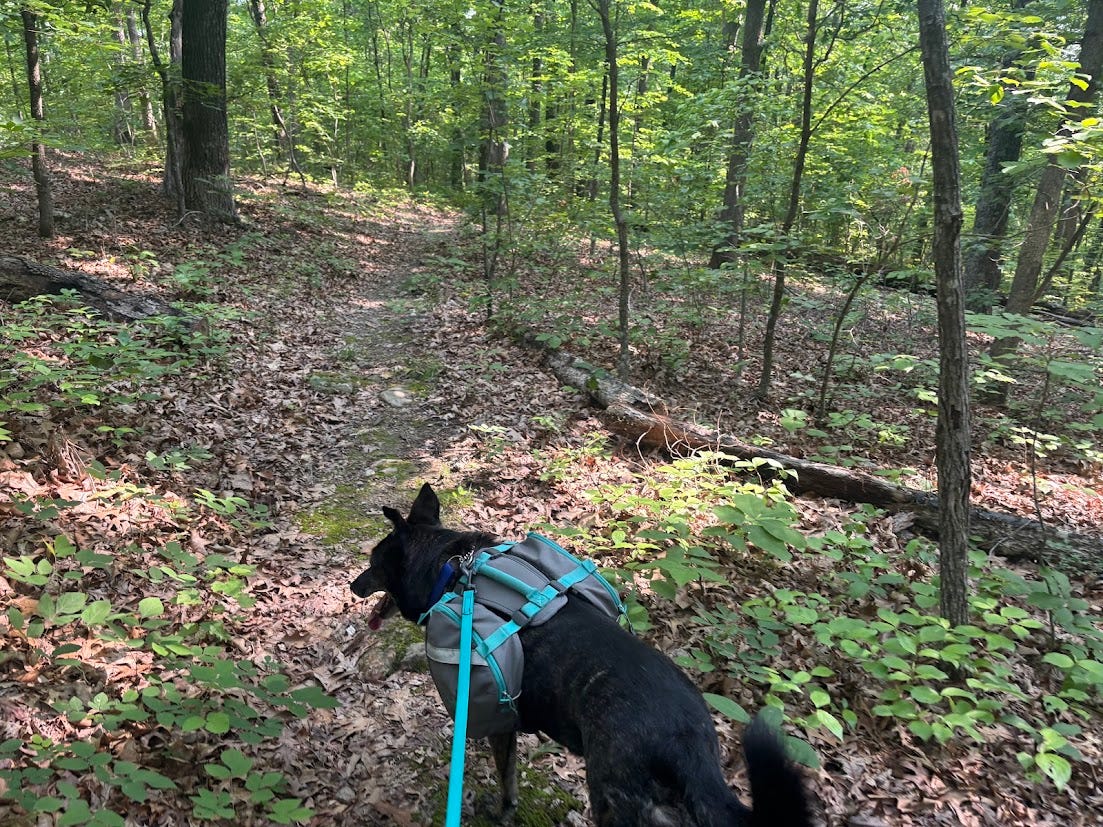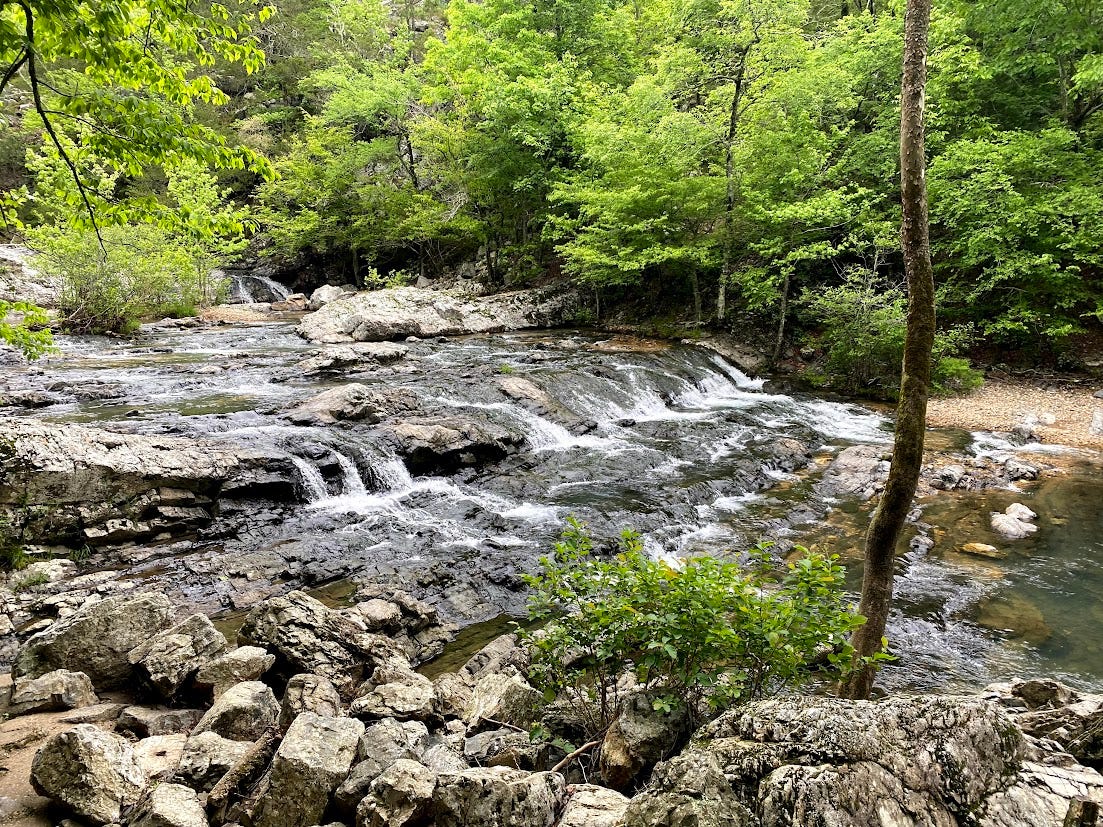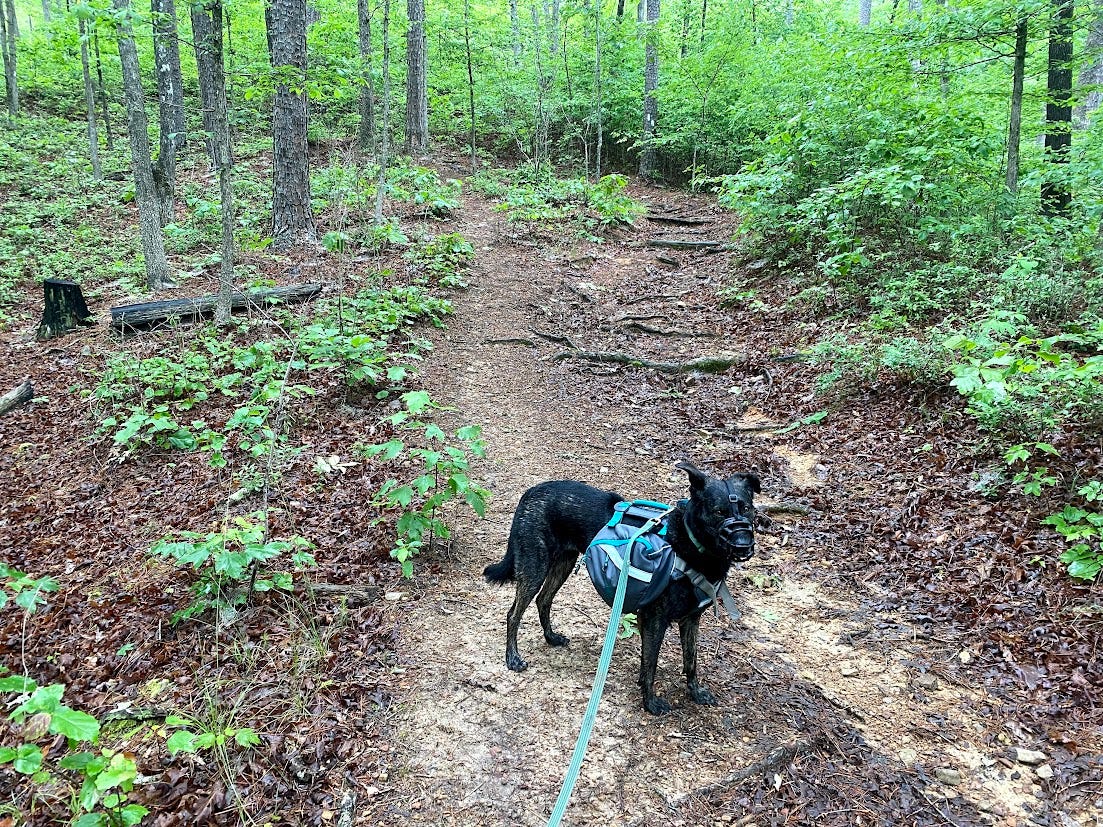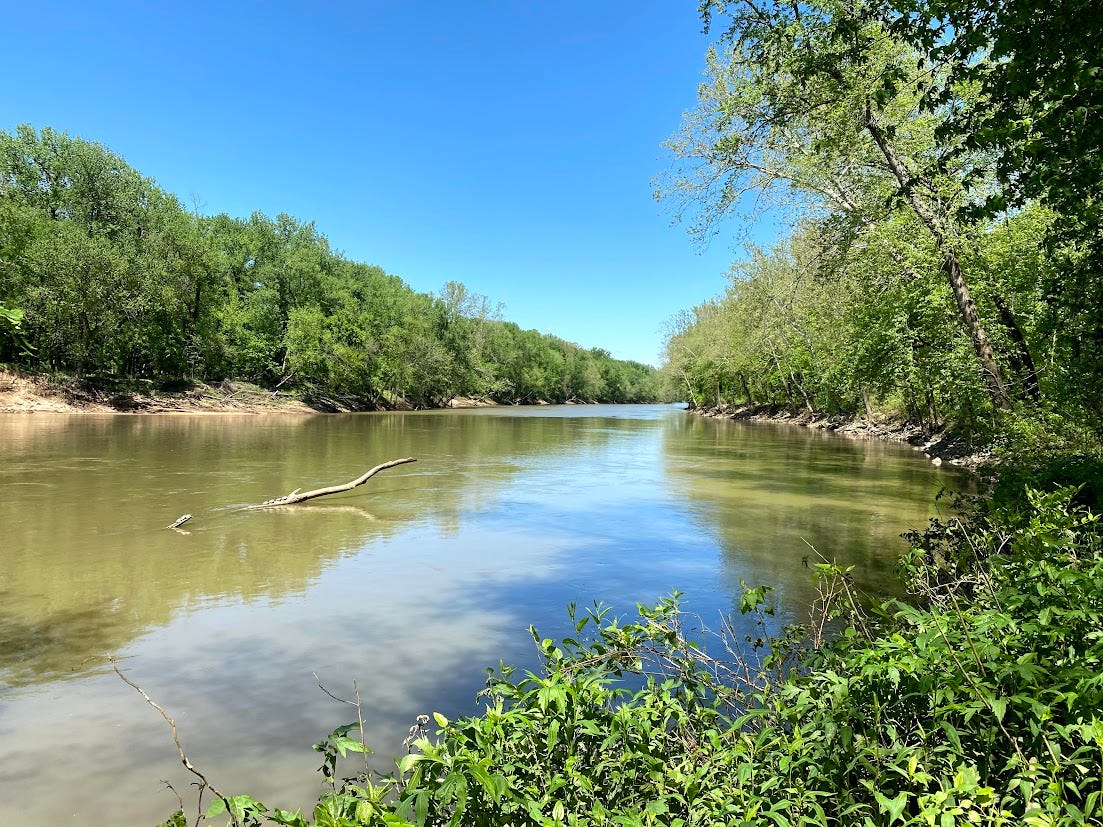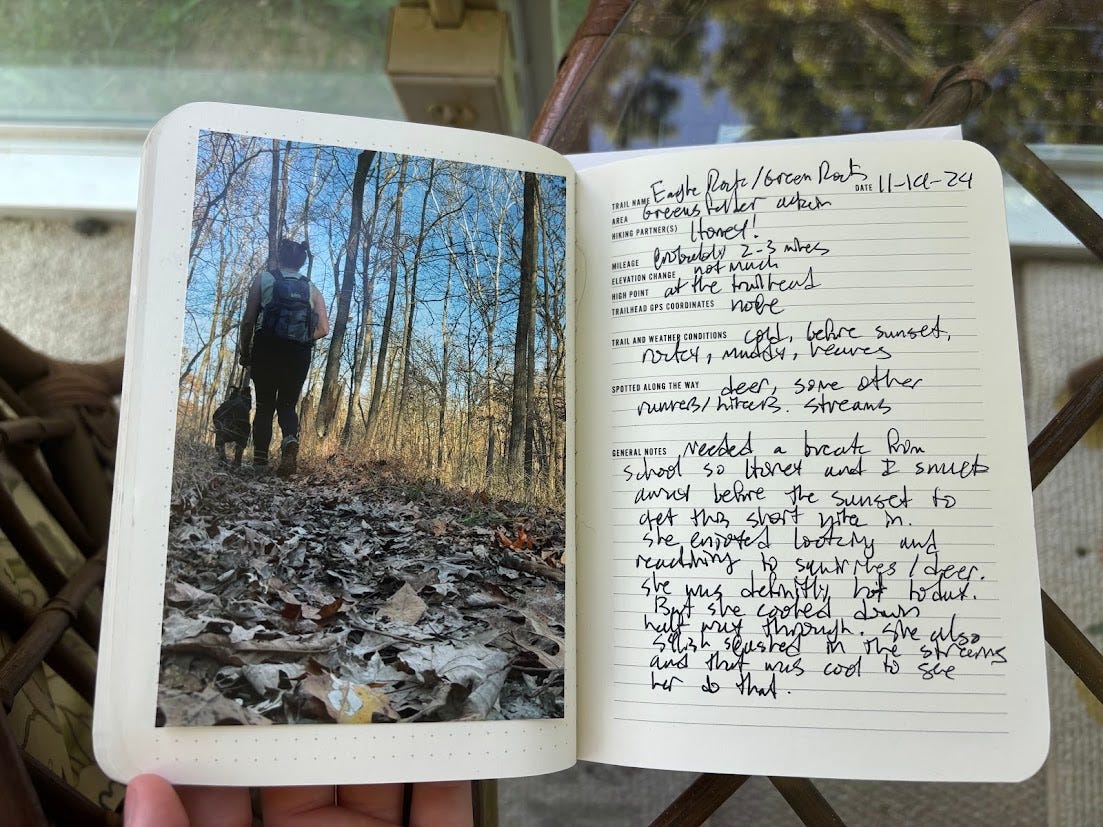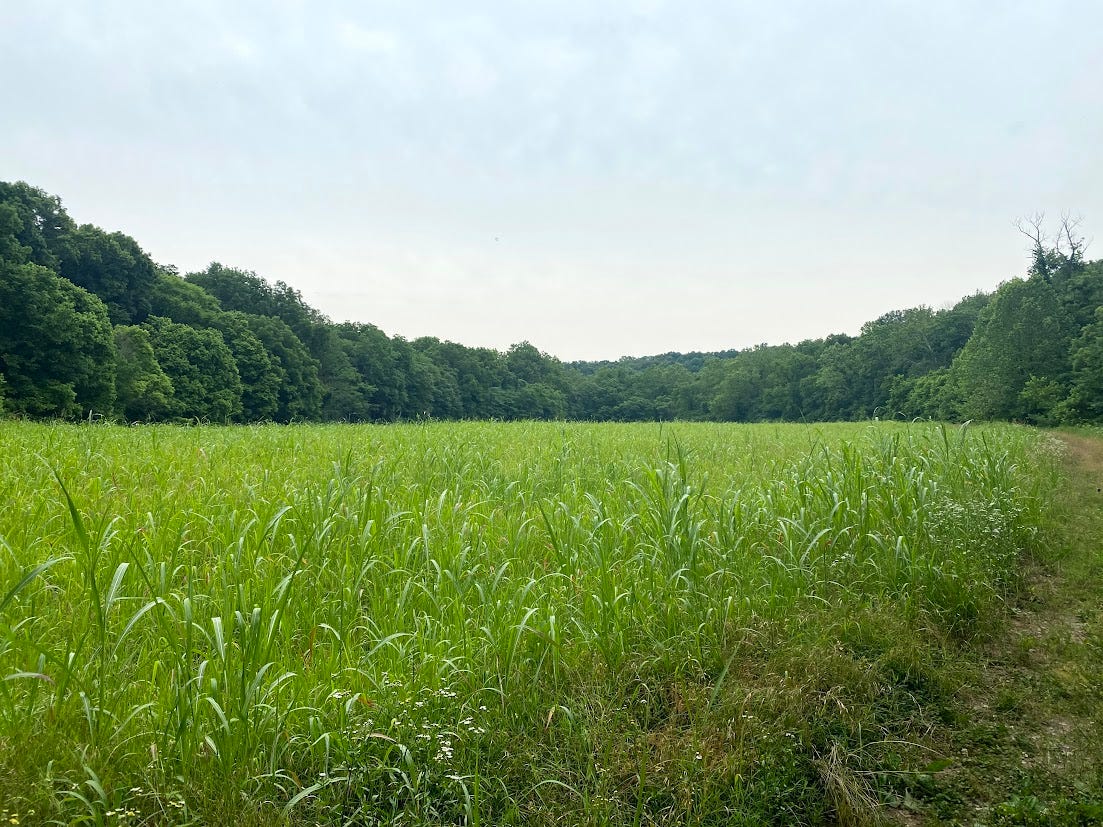My journey with journaling has been anything but linear.
In high school, I started documenting my life in an old leather notebook that I found buried in my sister’s closet. Like a true budding perfectionist, I set a goal for myself to write a few pages every single day, and if I missed a day, I needed to write even more the next time to make up for it. This quickly became a slog, but I stuck with my high expectations and ended up completing a few journals.
Callie Hikes is a reader-supported publication!
If you want to help out, you can do so by subscribing (paid or free) or Buying Me A Coffee below! Thanks for being here.
It wasn’t anything extraordinary. I thought back then that journaling was nothing more than just writing down what happened that day and the feelings or thoughts that went along with it. Like a diary. It wasn’t until I went to therapy and entered a treatment center for my eating disorder that I was encouraged to write for personal growth reasons. My treatment team would give me “agendas,” which are essentially writing prompts relevant to your unique therapeutic process that a therapist comes up with and assigns. I would then write in my spiral notebook and share it with my therapist during our sessions.
Example “agendas”
Write about your next relapse. How does it manifest and what are the triggers? Do a red, yellow, green. Red (signs of a relapse). Yellow (signs of heading toward relapse). Green (signs of being recovery-focused).
Write a letter to your body. What comes up when you think about your body and how has your relationship with your body changed throughout the years?
Write a timeline. This is your life story relevant to how your eating disorder formed and what you believe were the series of events that led to your mental health struggles.
After treatment, I walked away with an entire stack of notebooks filled to the brim with agendas, doodles I made during group sessions, and rants about having to eat ice cream after dinner. They are quite interesting to look back on and read. I think that’s one of the best parts about journaling. Not only is it helpful during the actual process of writing. But the full circle moments occur years down the road when you’re digging through keepsakes and suddenly you’re engrossed in reading about your 15-year-old self.
Throughout the years, I have continued to keep a journal (or several) to jot thoughts down, make to-do lists, or write about my depressed feelings. Sometimes weeks will go by, and I don’t feel the urge to pick up my pen to write. Then some months, I can’t bear the thought of not having a journal within arm’s reach at all times. As a writer, journaling reveals our most raw and intimate self. Part of the creative process is sharing your work with the world, yet having something to keep just for yourself and no one else is precious.
Since I have gotten back from my National Park adventure, the journals I have collected have mostly sat untouched. They are scattered around the house. Two on the glass table in the sun room. One on the downstairs coffee table. A few little ones sitting on the yellow bookshelf in my room. And plenty more blank ones crammed in my small closet. I write a lot already. I pour my heart out for this newsletter twice a week. I have a decently sized writing project growing on the side that I’ve kept hidden in the depths of my Google Drive. But something is missing.
I have been craving my journaling routine. This post may lack adventurous stories or teary, thought-provoking narratives, but it is instead a call to action. A reminder for myself and others that journaling is an important practice. Since this is primarily a hiking and trail-related Substack, I figured I would share some ways I have incorporated my love for the outdoors with my love for writing, as well as new things I would like to try.
What I have already done and continue to do
Trip reports
After a backpacking excursion or nature-filled adventure, one of my favorite things to do is write an account of everything that happened. Before I started this newsletter, I would process my experiences in the backcountry by writing them out on pen and paper in my notebook when I got home. Now, once I get a good night’s sleep and stuff my stomach full of Taco Bell, it’s a ritual of mine to sit at my laptop to draft a post about what occurred. Instead of waiting until the adventure is over, I have been trying to write a little each day while on the trail so that it’s easier for me to get a solid testament of my various thoughts or feelings.
*Note* Trip reports don’t always have to be for backpacking or overnights on a trail. They could be for any travel or camping experience that you do! They are a fun way to not only process the trip, but to commemorate and look back on later.
Keep a hiking specific journal
This is my ultimate favorite way to document day hikes or backpacking trips! I normally write out a few logistical pieces of information like mileage, elevation gain, trail name, hiking area, etc. Then, I dive a little deeper into who went with me, what I saw, and what the trail conditions were like. After that, I write a paragraph about how the hike went or note anything that stood out to me. Last, I order one picture from the hike that sums up the entire experience and tape it to the back of the page. It is so incredibly gratifying and fun to put together once a hike is over. It’s also just really lovely to have something physical to flip through and read/look at all the hikes you’ve completed throughout the year.
What I want to try
Poetry on the move
Several years ago, during the summer of 2021, I was in an emotionally vulnerable place. The pandemic was raging and people were dying. There was so much uncertainty in the world and in my personal life as I decided to drop out of college again. During all of this, I was started to get into trail running for the first time and I was really enjoying the process of building myself up to go farther distances. But the more my feet moved, the more my thoughts and feelings poured out of me. I would sit in my truck for a long time after leaving the trail to craft quick poems in the notes app of my phone.
Soon, I started to stop mid-run to sit somewhere along the trail and type away furiously. Getting a solid workout in became less important while giving myself space to feel things deeply took precedence. It was really exciting; sometimes I would leave the trail with chills on both arms despite the summer heat because tapping into my creativity just felt too good. Somewhere along the way, I stopped writing my silly little poems and fell into stagnation. I would love to get back into this routine again. It felt magical, flowing down the trail with ideas running along beside me.
One of my silly poems *enjoy*
When You Leave Me Behind
You fold your button down, place it delicately on the desk
You touch an apple at the store to see if it's ripe without leaving a bruise
You knead the flour-dusted dough and take your hands in mine gingerly threading, weaving together
It was like listening to my favorite song on repeat
I never wanted that moment, that feeling to end
But it was only when you reached out and held me like the water cradles the cup
that I knew this vulnerability was a short-lived gift
In my mind when you leave you’re half a world away and I learn to walk all over again
A running training log with special adaptations
Keeping a hiking journal has been very fun, but I think doing something similar for my trail running journey would be a good idea too. This is what I have in mind.
Document the logistics like miles, elevation, trail name, weather, and trail conditions.
Allow space to write about how the run went, how it felt, and jot down any revelations or things I discovered about myself.
Incorporate a countdown until the next race or goal
Include affirmations or mantras that feel relevant to the specific run
Visualization techniques (but write them out instead). Nerd alert: Sports Psychology is really cool. It was one of my favorite courses while getting my psychology degree. Basically, visualization is a way that athletes can overcome anxiety or mental blocks during training. I won’t go into too much detail here, but I like to visualize myself running on the trail or completing a hard task like going uphill or navigating tricky terrain to help mentally prepare myself.
Enjoy a little something I put together
For fun awhile back, I played around on Canva and made a small collection of trail-related journal prompts. Feel free to take a look and do some of them on your next hike or outdoor experience if you want!
That’s it for today! See you out on the trail!

